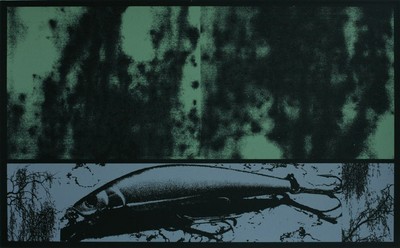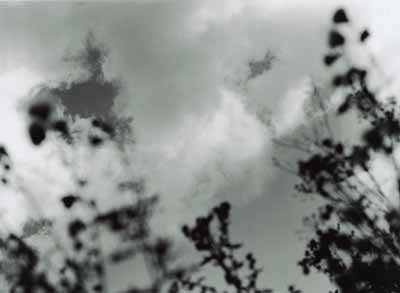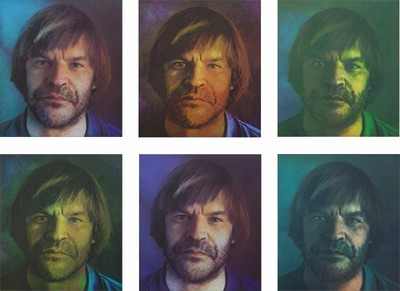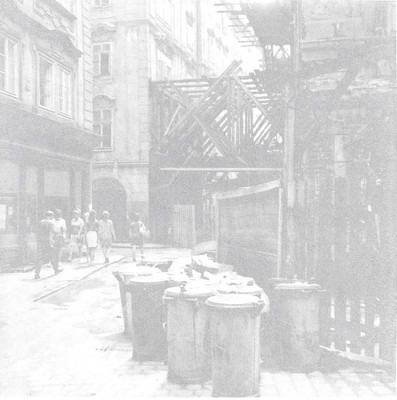Herman Isaksen
Birgitta Lorentzon
Jan Pettersson
Mats Wilhelmsson
20:e March - 5 April 2009
Herman Isaksen
Trondheim
I photograph urbane landscapes with traces of human activity. My picutures are an archeological documentation of human fingerprints in nature. I continue to work on the photos digitally in Photoshop and print them on a transparent folie. After that the images are transferred to printing plates or silkscreen covered with a light sensative emulsion. This process is made in a vaccum frame and in UV-light. Then they are developed in water and printed as a photopolymer graveur and a seriegraphy.
ARTISTS STATEMENT
The subject of my art is nature touched by the human hand.
A landscape of urban development created by city planners, architects and contractors.
Earth, water, wood, concrete, metal and glass.
Close ups of industrial areas where the winds of change gradually wipes out visible signs of the past.
My prints are an archaeological documentation.
What you see does not exist any more.
Herman Isaksen
Trondheim
Norway
23rd March 2006
Birgitta Lorentzon
Göteborg
Birgitta Lorentzon, printmaker – painter, lives and works in Gothenburg
During 1970:s studies at Valand School of Fine Arts, later experimental printmaking at Royal University College of Fine Arts in Stockholm.
The range of possibilities in the copperplate, from “light to dark” in etching and intaglio is fundamental for my printmaking.
I have always had an interest in the old analogue photographic handcraft and it’s treatment of light, but not until 1993 I started to work with photograveur as as a printmaking process. At that time as etched copperplates using a process that slowly creates the etched image in the plate.
For a theme exhibition at Röda Sten in Gothenburg 2003 I worked with a combination of analogue photography and photopolymer prints. The images and the rough exhibition room at Röda Sten together created visual wholeness. That way to exhibit suited my temperament and since then photopolymer has been added to my working materials as a complement to copperplates.
Birgitta Lorentzon
Jan Pettersson
Bergen
The true Lasse:
“The true Lasse” consists of 60 portraits as a starting point. For this exhibition I have choosen to show a selection of works from this project.
“The true Lasse” is about identification/personification and the creation of a visual profile of my friend Lasse, and how you as a spectator code this from knowledge of the person/gathered facts or from registered references and active fragments of memory. What are we looking at? Which one of the portraits is the “True Lasse” ? The answer might be none or all.
By working with the portrait in different versions I can place him in different situations(expressions) for the spectator to evaluate. The portrait is in a static state but the significant features we pays attention to as spectators, are moving together with us from picture to picture. Can we interpret an individual’s psychology through a portrait and could it in turn be seen as answers to the questions around our own theory of it? The subconscious identification of being inside the experience in the past, present and future, not to leave it but to remain and overcome it from the inside.
Jan Pettersson Bergen 27 01 09
EVENTUAL CLUES FOR SEEING
“THE TRUE LASSE”
(I)
*) The tradition of portraiture: the autonomy of the individual:
providing metaphysical significance to the self-regard of the bourgeoisie
*) Providing appropriately symbolic forms for social meaning:
social prestige – status – power – respect for authority
*) Psychology: the essence of the individual: portraiture as a
landscape
“Tymotheo”: LEAL SOUVENIR (Loyal Remembrance); painting by Jan
van Eyck, 1432; similarity as a sign of equality
*) (Technique)
Optics: Educating the visual: seeing “right; focussing on the retinal;
compositional devices; seeing through aesthetic construction
Optical devices: instruments designed to “see through”: telescopes,
microscopes, eyeglasses, spyglasses, camerae obscurae, magic lanterns
*) Photo: spontaneity vs aesthetic construction
*) The post-modern: Donald Judd: “Unfortunately, art tends to become
a likeness, but that’s not really what it is” (value judgement indeed …)
*) Fetish – Icon – Representation
If the original notion of the icon was that of reproducing the “essence” of a
particular being, by now we tend to believe that icons in contemporary
visual arts have become mirrors upon which we try to catch a glimpse of
our (self-reflection) own gaze.
*) Portrait of a dog, of a horse, of a cow, of a friend?
*) The “Other”:
Meeting Lasse is meeting his “other”, that is, meeting ourselves in the
condition of viewers.
Meeting Lasse is to meet our own gaze looking at him.
*) Social devices: representation is no longer connected to the certainty
of a rational, general or correct interpretation of Thing, but rather to the
possibility of negotiating, sharing or confronting a dialogue about the
“represented” or assumed objects.
*) Language: if we assume the idea of expression as a process rather than
as a concrete and final product, then portraying Lasse is equal to the act of
both talking about him and talking to him, and every single word used in
this operation is part of the song we sing through and to each other.
*) The contemporary: it could happen that the man called Lasse may be
present at the show …
(II)
LASSE
Nikos told me a story he had heard from a Canadian:
A wealthy prince from the Middle East wanted to add to his treasure
a masterpiece of art. He invited an artist from the farthest kingdom to the
West and another from the farthest kingdom to the East, to compete for a
prize.
A Greek and a Chinese arrived. They shared a space divided by a huge
drapery.
The Chinese started at once with long working days, whereas the Greek
invited the local artists, philosophers and poets to visit whenever they
wanted. His space was always full of people.
Then, one day, the prince announced the time had come to show him the
results.
The Chinese showed a great painting with clouds, mountains, rivers,
pathways, temples, characters, animals and blades of grass. The prince was
amazed and expressed his wish to wander through the landscape, the most
beautiful he had ever seen.
As he had already heard talk of the Chinese’s industry and the Greek’s
constant partying, he asked, with mistrust, for the drapery dividing the
spaces to be removed.
To his surprise, he found himself surrounded by a sublime landscape.
Entranced, he walked into it.
On his wall, the Greek had mounted a wide mirror reflecting the work of
the Chinese.
Anthropology proposes that one way of constructing identity is the consciousness
of the Other. On the other hand, Lacan’s psychoanalysis mistrusts the impurities
of the Self whose construction is based on the image reflected in a mirror. The East
speaks of the illusion of the Self, and Master Eckhart says that “the eye with which
I see god is the same eye with which god sees me.”
Text by Carlos Capelán
From the text , Please join the Party by Prof. Søren Kjørup
In the project “The True Lasse”, where we are directly invited to do our own coding of the work.
What do we really see here? Which of the many renderings of Lasse shows us the real person? The answer, obviously, is both “None” and “All”. The real Lasse is of course a human being in flesh and blood, living and moving and changing through time, but what we see here are only a series of reflections of a reflection, prints made from an original photograph that has captured just a very short moment in time. But in another sense all of them show us the real Lasse, or perhaps better a real Lasse, as each of them shows us one aspect of his personality (or at least: a possible aspect of his personality – since I am not sure that all the sinister-looking highwaymen in the series give away Lasse’s real personality).
What is more important, however, is that by making all these different prints of the one original photograph, Jan Pettersson reminds us that also one “original” person does not have just one look, corresponding to just one personality. We are all constantly moving, changing our looks, our expressions, our visual moods. And seen in this way, the title “The true Lasse” should not only be read as an invitation to find the true Lasse in one of the prints, but to realize that the true Lasse is not a person we meet in one specific print, but in the full series, taken as a whole.
Mats Wilhelmsson
Stockholm
My prints for this exhibition are photograveurs. They are made by using the old technique on copperplate, with pigment paper and etching in iron chloride.
One of the series of images is motifs from Prague and are some of the first photograveurs I made. The other series of images is pictures from Istanbul and they were made almost twenty years later. Now I have “recovered” them again and seen a relationship between them. By printing the graveurs in a completely different way than before, by using the same paper size and the same ink, I want to stress what they have in common. The bright color and the somehow “hazy” expression is an attempt to transform the describing character of each image to a new wholeness that hopefully tells a partly different story…
Mats Wilhelmsson





